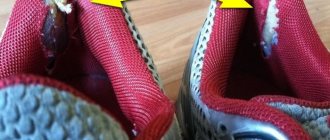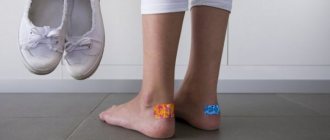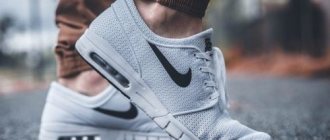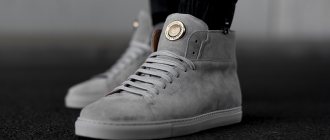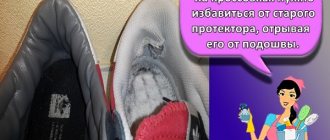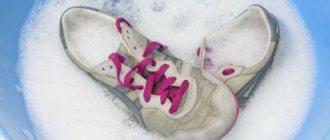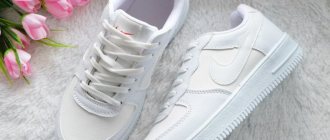September 19, 2020
Sneaker care
Mesh fabric is a traditional element of many branded sneakers, especially summer, running, and for indoor activities. The material is durable, but still not as strong as leather or special fabric from which shoe uppers are sewn. Therefore, sneakers with mesh are more vulnerable to mechanical damage, and an unsightly hole in the mesh fabric instantly turns your favorite shoes into a throwaway product.
But is everything so irreparable, or, if the mesh is torn, can you repair the sneakers yourself? The answer is clear: you can! Moreover, there are a lot of ways.
General recommendations
When planning to restore sneakers, you need to take into account that different models differ in the materials used to make sports shoes. Depending on the material, the nuances of further repairs depend. The main task of the work is to update shoes and maintain proper appearance. Without going to a workshop, you can easily glue or extend the sole, whiten the visible part of the products, and eliminate small cracks.
The toe of a sneaker is most susceptible to wear and external influences, which is why tears most often form on it. The toe section is constantly in need of repair due to increased load, so the restoration of this element should be approached with great responsibility.
Even if worn and handled carefully, sneakers will wear out faster than other shoes, especially when used for sports. Prolongation of operation is facilitated by timely repairs and compliance with preventive care measures. This reduces costs compared to purchasing a new pair of sports shoes.
DIY tread repair
The most vulnerable are the protectors located on the heels of shoes. To restore them, you will need a hard piece of rubber, which can be taken from the sole of unnecessary shoes. Among the tools and additional devices that will be useful for work are: shoe glue, a sharp knife, and coarse sandpaper. The tread repair process is as follows:
- A patch is cut out of a piece of hard rubber and fitted in place of the damaged or worn out tread.
- Using a knife and sandpaper, make a wedge-shaped patch.
- The surfaces that will be glued are treated with sandpaper to roughen them, and then wiped with a solvent and allowed to dry.
- The adhesive composition is applied in two layers to the patch and the future location of the protector. The drying time of the first layer should be about 20 minutes, the second - 4-6 hours.
- After the glue has dried, the surfaces are heated over the stove until a smell appears, applied to each other, squeezed tightly and held until cool and fixed.
Sneakers with retreads can be worn immediately after the repair is completed. If possible, it is recommended to wait a day before use to provide additional reliability.
How to stitch shoes
Choosing a tool for stitching shoe soles is a very important point, since the quality of the work done, its reliability and durability ultimately depend on what tool we use.
Special shoe hooks are used for sewing on shoes.
And they must meet the main, in my opinion, requirements for them:
- ensure the sole is sewn to the bottom of the shoe without destroying it;
- do not tear or unravel the thread while working;
- withstand a long service life without breakdown.
Fig.5 Hooks for stitching shoe soles
Almost all shoe hooks that are sold by craftsmen are not suitable for their intended purpose and, when used with them, they damage shoes and quickly break themselves.
This, most likely, is where people’s prejudice towards sewing their shoes lies, as something unsightly and barbaric, while they completely forget the fact that earlier, even before the advent of shoe glue and metal nails, shoes were sewn by master shoemakers exclusively using special needles and awl.
The shoe hook, as a kind of hybrid of a needle and an awl, appeared relatively recently, in the fifties of the last century, and immediately gained popularity among both professionals and ordinary people.
But unlike a thin and sharp needle with a thick eye for thread; the hook is like an inverted needle with a cut, instead of a closed “eye”, like in a needle.
If such a cut in the hook is made correctly, then brought to the required depth with the thread that he will use for sewing, with GOI (State Optical Institute) paste applied to it, then such a hook will be easy to use, will serve for a long time and, most importantly, Do not damage your shoes when using it.
Therefore, I mainly buy hooks for sewing on soles in a special store and then independently adjust them to a specific thread.
How to repair heels
To repair heels on sneakers, you need to get rid of the old tread, tearing it off the sole, cutting it in places where it is impossible to separate the element manually. To simplify the task, you can treat problem areas with a solvent.
After removing the tread, the contour of the sole is transferred to thick paper or cardboard and the erased edges are completed. Having drawn the outline, the pattern is cut out of paper and used to create a new blank. You can make the sole from a rubber mat, which is sold in hardware stores. It is impractical to partially restore the sole, so if the heel of the sneakers is damaged, the base is completely changed.
When gluing the sole to the main part of a sports shoe, you need to thoroughly clean the surface. Otherwise, the gluing procedure does not differ from the standard one.
How to repair the top
The features of repairing the upper part of the sneakers directly depend on the material used. If shoes are made of suede, natural or artificial leather, then the material wears out over time and cracks at break points. To restore the appearance, patches made of thin and elastic material can be glued or sewn onto cracked and cracked areas. Before applying patches, the old material is torn off.
The use of patches on the upper part of the sneakers ruins the original appearance of the shoes, so it is better to prevent cracks from occurring. To maintain shoes in good condition, natural leather should be periodically lubricated with cream, and suede should be cleaned with a dry, stiff brush, trying to lift the pile. To clean the upper part of your sneakers from dirt, you should use a damp cloth rather than washing your shoes under running water.
Mistakes when stitching shoes
The most common mistakes are the following:
- when piercing the sole with a hook, you must not “screw it in” to avoid breaking it;
- the hook must completely capture the loop, otherwise when pulling the thread it will unravel and tear;
- do not overtighten the thread when pulling it under the sole and insole; firstly, it may break, and secondly, it may “cut” the sole:
- if the thread is unwaxed, then it must be “passed” through a piece of beeswax or soap;
- You cannot sew without preliminary gluing, if necessary.
Sole
The quality and condition of the sole affects the comfort when wearing sports shoes. With prolonged use, the sole of the sneakers wears out and becomes deformed. Stepping on stones and unpaved surfaces risks damaging the sole, causing holes to form on it.
How to seal a hole
Any holes in the sole can be repaired in different ways, depending on the base material of the sneakers and the extent of the damage. Most often, epoxy glue is used to eliminate holes, which is relatively affordable and easy to use. Holes on the sole are sealed as follows:
- all edges of the hole are well cleaned and treated with a solvent to degrease;
- when the area next to the defect is completely dry, apply the diluted adhesive composition;
- if the hole in the sole of the sneaker is too large, a fiberglass mesh is placed in it to fill the void;
- when the glue dries, cover the damaged area from the outside with masking tape to level the sole;
- The sneakers are left in a well-ventilated area to dry completely.
How to increase worn out
If the soft sole of the sneakers has worn down slightly, it can be increased to its original thickness. For this purpose, you will need to purchase microporous rubber. A blank is cut out of the material in the shape of the worn-out element, the surface is cleaned with sandpaper and glued to the shoes.
It is better to use a special kind of shoe glue as glue to ensure reliable adhesion.
Replacement
A sole with a lot of damage is easier to replace with a new one. This will significantly reduce the time spent on repairing each damaged area. The replacement sole, as well as for extension, is cut out of microporous rubber. The sneaker is applied to the cardboard and the outline is outlined, and then it is transferred to the prepared material and the blank is cut out.
What kind of shoes can be stitched?
Before moving on to the description and analysis of stitching methods, I will briefly discuss the choice of shoes suitable for stitching.
Based on my experience, I can say that almost any sole, regardless of what material it is made of, can be stitched, be it rubber, polyurethane, leather, elastomer or even micropore.
Fig.1 Shoes with cast soles with a groove for stitching
However, there are shoes whose soles are made predisposed to stitching, the so-called cast sole
with a high side (lip) and with a groove, which is located on the side along the sole or on the bottom of the sole, these are mainly winter shoes, some models of sneakers, summer sandals and autumn-spring shoes, again with a molded sole, Fig. 1.
Fig.2 Shoes with molded soles without grooves
Shoes with cast soles without a stitching groove can also be stitched, Fig. 2 and Fig. 3.
Fig.3 Shoes for stitching, thread groove mode
In such shoes, if necessary, a recess for the thread (groove) is first cut on the side or bottom with a special tool (groove cutter), Fig. 3
or you can stitch without a groove at all, but if the seam needs to be done from the bottom, then you will simply need to glue the outsoles onto the sole prepared in advance for this purpose in order to protect the stitching made.
Combination top repair
On sneakers with a combined upper made of synthetic material with foam padding or natural and artificial suede, the fabric most often damaged is in the toe area, where the shoe comes into contact with the toes. On the outside, this area can be protected by a rubber insert around which there is a mesh, which is typical for running models of sneakers.
If there is minor damage to the front of the shoe, a patch can be sewn on. If there are large holes, you need to prop up the seams, adjust the size and shape of a piece of durable nylon fabric and sew it in place.
What to do if the mesh on your sneakers is frayed or torn
Even the best quality sneakers can tear or become damaged. To avoid throwing away a good pair of shoes, you should try to repair them yourself.
Sew with thread if a small area is torn
You need to take a thread that matches the color of the sneakers and a needle. A needle is inserted into the holes in the mesh and gradually pulls the material until the seam hides the torn area. You need to sew not along the edge of the hole, but a little further, capturing more fabric. This will prevent the shoes from tearing again when worn. When the seam is completed, you need to tie a tight knot and trim off the unnecessary part of the threads.
The seam should be small and tight. This way it will look neater and last longer.
How to fix a backdrop
Damage to the back of sneakers manifests itself in different ways: the fabric tears, the inner lining comes out, and discomfort appears in the heel.
When repairing shoes at home, you can take the following steps:
- Carefully cut off the torn edges in the area where the lining is located.
- Select a piece of thin leather that is soft to the touch and cut the blank in the shape of a small horseshoe. This shape is required to cover the entire surface of the heel of the sneaker.
- Treat the leather blank with shoe glue, thoroughly covering the entire surface, especially the edges.
- Carefully apply the patch to the heel of the shoe and place any suitable size object inside the sneaker to spread and press the fabric tightly.
- Leave the shoes for several hours for the final fixation of the patch.
How to reduce the number of cracks
A common cause of cracks in sports shoes is improper use. In particular, defects appear on sneakers due to wearing shoes of a larger size, excessive bending of the foot while wearing, prolonged pressure, exposure to high or too low temperatures.
If you follow the rules for using shoes, cracks will appear on them in a minimal amount.
To reduce the number of damages, it is recommended to use special mold holders, blocks and spacers during storage. It will also be useful to stuff the sneakers with crumpled paper to flatten the shells. Another factor that leads to the formation of cracks is soiled shoes. When a large number of dirt particles accumulate, the number of cracks increases and they grow faster. For this reason, the products should be kept clean.
What threads are used to sew shoes?
Most often, for stitching shoes, the so-called round twisted nylon shoe thread of different thicknesses is used, which differ from each other, respectively, in thickness and marking.
I use nylon thread No. 375 and No. 280, three hundred and seventy-five thicker.
Fig.6 Nylon thread for stitching shoe soles
Shoe thread is sold in small spools weighing 25 grams or large spools, comes in various colors and is additionally impregnated with wax.
In addition to a special round nylon thread for sewing, a flat waxed polyester thread is also used, but working with it requires additional skills, so I will not dwell on it in this article.
How to properly care and wear
To extend the service life and maintain the proper appearance of your sneakers, you need to follow a number of simple rules. In particular:
- Take off and put on sneakers unlaced. If you do not untie the laces, the resistance on the heel will increase, which will cause its deformation.
- Only wear shoes that are the right size. Otherwise, abrasion will occur faster.
- Use the correct type of running shoes. For running, training and everyday life, appropriate types of shoes have been developed, so you should not limit yourself to one pair, but choose a separate option for each type of activity.
- Buy quality shoes. Attempts to save money often lead to accelerated wear and tear and the appearance of a large number of defects, as a result of which you have to constantly carry out restoration or throw away the sneakers.
Share link:

